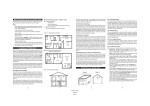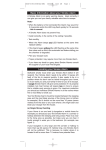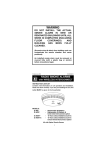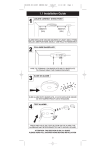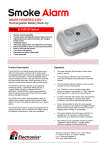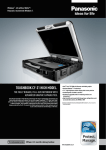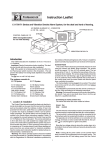Download W:\U&C Books\EI175\175ins.vp
Transcript
Professional ® Instruction Leaflet EI 175/176 Strobe and Vibration Smoke Alarm System for the deaf and hard of hearing CONTROL PANEL EI 173 9V SMOKE ALARM EI 100CD - IONISATION (or EI 105CD - optical) STROBE (With rechargeable battery for one week standby) VIBRATION PAD EI 174 Important: Read all instructions before installation. This leaflet must be left with the end user after installation. Control Panel The Control Panel should be permanently fixed to the wall using the screws and plastic plugs enclosed. The screws should be spaced 114 mm (4.5 in) vertically apart. The top screw will be 27 mm (1.1 in) below the top surface of the control panel when installed. The screws (large heads) should be screwed into the wall leaving a gap of approximately 4 mm (0.15 in) under the head. Fit the keyhole slots on the back of the control panel over the screw heads and slide the panel down vertically into position. The mains adaptor can be plugged into a socket. The socket must not be used for any other equipment and it must always be switched on. Introduction This leaflet describes the installation of the EI 175 and EI 176 Systems. If the system is not being used for some time the control panel power switch must be off to prevent the battery from being totally depleted and possibly damaged. Do not turn on until it is fully wired. The systems consist of:EI 175 System EI 176 System Smoke Alarm EI 100CD (9V ionisation) Control Panel EI 173 (with built-in strobe) Vibration Pad EI 174 Smoke Alarm EI 105CD (9V optical) Control Panel EI 173 (with built-in strobe) Vibration Pad EI 174 It is preferable to permanently wire the unit into a mains junction box. Wire according to the following instructions. Warning: First remove the power to the circuit at the distribution board. If you are in any doubt about how to do this, get help from a qualified electrician. The entire system is powered from the AC mains through a low voltage transformer. In the event of a mains failure the rechargeable battery in the control panel is capable of powering the total system, including up to 12 interconnected smoke alarms for one week, followed by at least four minutes alarm. Connecting to mains junction box. The mains lead wires are colour coded as follows: 1. Location and Installation brown: live blue: neutral The Control Panel should normally be fixed such that the internal strobe light can be seen from the bed and the vibration pad can be placed under the pillow or mattress. It has to be powered from the mains (230 VAC), so a suitable power point or junction box must be available to which it can be permanently connected. The Smoke Alarm must be located as described in the Smoke Alarm instructions supplied. Cable (10 m) is supplied to connect between the Control Panel and the smoke alarm. This can be extended up to 50 m (20 ohms max.) with suitable low voltage cable if required. The smoke alarm supplied with the system may be interconnected with other EI 9 Volt interconnect smoke alarms (EI 100C /105C /103C only), up to a maximum of 12 smoke alarms in total. Many dwellings require more than one smoke alarm for minimum protection. See the smoke alarm instruction leaflet for detailed advice on, location, maintenance etc. The wire which is coloured blue must be connected to the terminal/wire which is marked with the letter N or coloured black. The wire which is coloured brown must be connected to the terminal/wire which is marked with the letter L or coloured red. The apparatus is not to be earthed, so no connection is to be made to terminals or wires marked with the letter E, the symbol or coloured green or green and yellow. Bring the low voltage wiring to where the smoke alarm is to be located. Route all wires neatly and securely along the walls and ceilings. Note: Turning off the power switch on the Control Panel does not switch off the apparatus from the supply mains. The switch removes the AC and battery power from the Control 1 Panel, but the mains transformer remains connected to the supply mains. Fig 2. Interconnecting Smoke Alarms Vibration Pad Plug the vibration pad into its locking socket on the control panel. Place the vibration pad under the pillow or mattress. It is important that the person in the bed can feel the vibration check it is sufficient to wake a person by lying on the bed and pressing the test button on the control panel - see also “Testing your system”. Some mattresses may not transmit sufficient vibration and in these cases it should be fitted under the pillow. Note: During testing, or in an actual alarm situation, the pad pulses on and off for greater effect on sleepers. TERMINAL BLOCK (NOT SUPPLIED) BLUE TO TERMINAL 1 BLACK TO BLACK Smoke Alarm YELLOW WIRE NOT CONNECTED 1. Choose the smoke alarm mounting position following the siting instructions in the smoke alarm leaflet and screw it into position. 2. Connect the red (remove the small piece of insulating tape first), yellow blue and black wires from the control panel EI 173 to the terminals marked “R”, “Y”, “BL” and “BK” respectively, as shown in figure 1. RED TO RED BATTERY CONNECTOR REMOVED SMOKE ALARM EI100C/EI105C 4 CORE WIRE Fig 1. Control Panel connection to Smoke Alarm R Y BL BK TO CONTROL PANEL EI173 RED YELLOW BLUE BLACK R Y BL BK 3. Testing your System After Installation 1. Plug in the control panel mains adaptor (or turn on the AC mains if it is connected to a junction box). Slide the power switch on the side of the control panel to the “on” position. Check the continuous green light on the control panel cover is visible. The red light behind the the test button on the smoke alarm will flash every 40 seconds to show the unit is receiving power. 2. Press the test button on the smoke alarm. The smoke alarm should sound and the red light behind the button will flash every second. After about 4 seconds the control panel will turn on the strobe light and the vibration pad. Two people may be needed for this test. Interconnected smoke alarms, where present, must also be tested. 3. Press the control panel test button. Check the vibration pad is on and that the strobe is flashing. TO CONTROL PANEL 2. Interconnecting Smoke Alarms A maximum of eleven EI 100C/105C/103C nine volt smoke/heat alarms may be interconnected to the EI 100CD or EI 105CD Master Smoke Alarm. A maximum of 250 metres (820 feet) of signal/alarm cable can be used, (maximum resistance 50 ohm). Use only one Master Smoke Alarm per system. Warning: Do not connect these Master Smoke Alarms to any other type of EI alarm, or to any other model produced by another manufacturer. Doing this may damage the alarms and could result in a shock or fire hazard. When one alarm senses fire all interconnected units will sound and the control panel will turn on the strobe light and vibration pad. The wiring between the smoke alarms requires three cores, two for power and one for interconnect, as shown in figure 2. (Four core signal/alarm cable is suitable for this and the wiring colours illustrated in figure 2 assume this is being used). The master smoke alarm unit is connected to the control panel as described above. Then all the rest of the units being interconnected are wired to this master unit, as shown in figure 2. On the second unit cut off the battery snaps and connect the battery wires to a two-way terminal block (not supplied). Connect the red and black power leads from the master unit to the other side of this terminal block. Connect the “BL” terminal from the master unit to the number 1 terminal on the second unit, using the blue core wire. Note the yellow wire from the control panel only goes to the master unit - it is not connected to any of the other units. Wire the third and subsequent units, up to a maximum of twelve, in the same way. Daily & Weekly Testing We recommend that you test your system weekly by pressing all the smoke alarm test buttons and checking that the vibration pad and strobe light are operating. Also check at the same time that the green power light is visible on the control panel and that the red lights on all the smoke alarms flash every 40 seconds. Check daily that the vibration pad is in its correct position by pressing the test button on the control panel. Periodic Testing of Rechargeable Battery The rechargeable battery takes about 20 hours to charge from the control panel when it is first powered up. The panel then maintains it in the fully charged state by continuous trickle charge. In the event of a mains failure, the battery will power the system, including up to 12 interconnected smoke alarms, in standby for a week followed by at least 4 minutes alarm. When the mains fails, the green light is extinguished and the red light flashes rapidly on the control panel to indicate it is on 2 This is done by connecting together electrically the red and blue wires, from the control panel, by means of a switch or volt-free relay isolated contacts. The wires from the switch can be connected into the circuit at the terminal block of the master smoke alarm EI 100CD or EI 105CD. battery power. If the battery is starting to be fully depleted the red light will go off to indicate the system is totally unpowered. The battery will last 5 years in normal use provided it is not exposed to extremes of temperature for prolonged periods, or fully discharged/charged a large number of times. We recommend that the functioning of the rechargeable battery is checked at least yearly as follows: (i) Ensure the control panel has been mains powered for at least the previous 20 hours for the battery to charge. (ii) Turn off the mains power to the control panel by unplugging, or switching off the circuit at the distribution board. Check that the green light goes off and the red light starts to flash on the control panel. (iii) Press the control panel test button for 20 seconds and check the strobe flashes brightly and that the pad vibrates strongly. Check that the red light continues to flash while the test button is pressed. (Cover the strobe light with card to stop this dazzling you while looking for the red light). This red light flashing indicates that the battery is satisfactory. If the red light goes off, or if the strobe is weak, or if the vibration is weak the battery will need to be replaced. Contact the nearest address in this leaflet for advise about getting a replacement. (Note: If you are using a manual fire alarm switch in conjuction with an EI Locator Switch EI159 you must put a 2.2K ohm resistor in series between the fire alarm switch contacts and the interconnect blue, wire. This is to limit the current to the EI159 unit). Power Requirements The typical currents at 230 VAC are • Standby 10 mA 50 mA • Alarm 6. Product Guarantee EI Electronics guarantees this system for one year from the date of purchase against any defects that are due to faulty materials or workmanship. This guarantee only applies to normal conditions of use and service, and does not include damage resulting from accident, neglect, misuse, unauthorised dismantling, or contamination howsoever caused. This guarantee excludes incidental and consequential damage. If this system should become defective within the guarantee period, it must be returned to the nearest address in this leaflet, carefully packaged, with the power switch on the control panel in the off position, with the problem clearly stated along with proof of the date of purchase. We shall at our discretion repair or replace the unit. Do not interfere with the system or attempt to tamper with it. This will invalidate the guarantee, but more importantly may expose the user to shock or fire hazards. This guarantee is in addition to your statutory rights as a consumer. 4. Troubleshooting If the units fail any of the tests outlined above after installation, the system has probably been incorrectly wired and/or all units are not connected. Check all wiring carefully. If the green power light on the control panel is not on, check the power switch on the control panel is on. Check the wiring to the mains and that the mains is not off (e.g. due to a tripped circuit breaker or fuse). The Control Panel monitors the wiring to the vibration pad and the master smoke alarm for faults as follows: (i) If the vibration pad is removed or if its wiring is open circuit, the control panel will flash the strobe. (ii) If the wiring to the master smoke alarm is disconnected, open circuited or short circuited, the control panel will turn on the vibration pad and the strobe light. Manufactured by EI Electronics. Shannon Co. Clare Ireland. There are no user serviceable parts in this unit. If it is thought to be defective, it must be returned to the manufacturer for repair or replacement (see “Product Guarantee” section). ©2000 P/N B12207 5. Accessories and other Features Control Panel “Aux. Output” The auxiliary output turns on when the control panel is in alarm and can supply up to 200 mA at 12 Volts (range 10 to 14 Volts). (Note: the positive terminal is the pin next to the “Clock Input” socket). An Auxiliary Strobe EI 178 is available and is supplied with 10 m of cable and a suitable plug. It can be located, for example, where it is readily seen during the day (e.g. downstairs hallway). An extra Vibration Pad EI 174 is also available with 2 m of cable and a plug for connecting it to the auxiliary socket. Control panel “Clock Input” socket A suitable alarm clock (with a 5 to 24 Volts AC or DC output electrically isolated from the mains supply) can be connected to this input socket with a 3.5 mm mono jack plug. When the alarm clock triggers, the vibration pad turns on to wake the person, but the internal strobe or auxiliary output do not turn on. This lets the user know it is a wake-up call and not a fire. Therefore the user needs only one vibration pad under their pillow or mattress. Triggering Control Panel into Alarm Externally A manual fire alarm switch (e.g. a glass break type) can be used to get the control panel to turn on the vibration pad, strobe light, and the smoke alarm horn. 3



